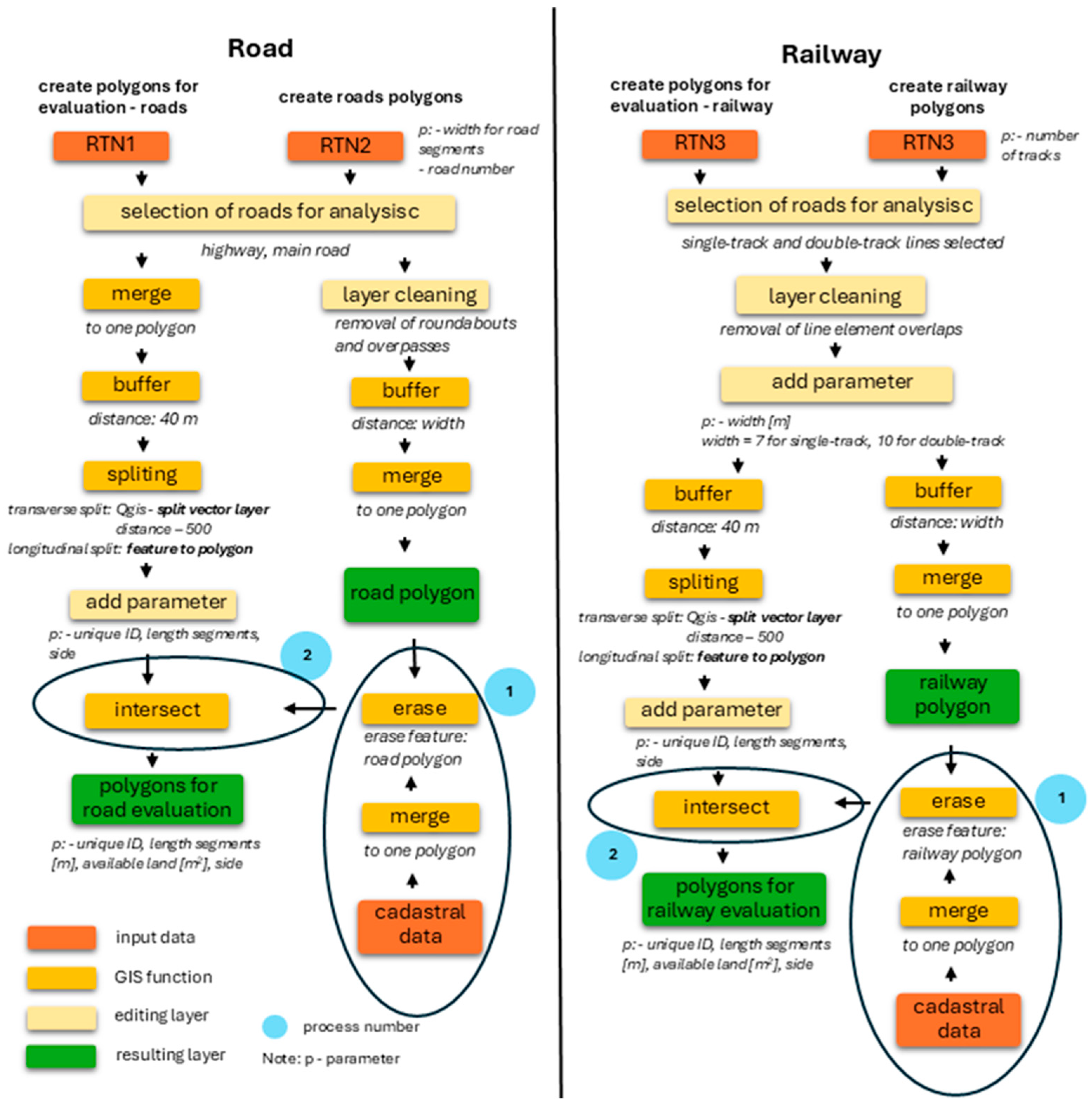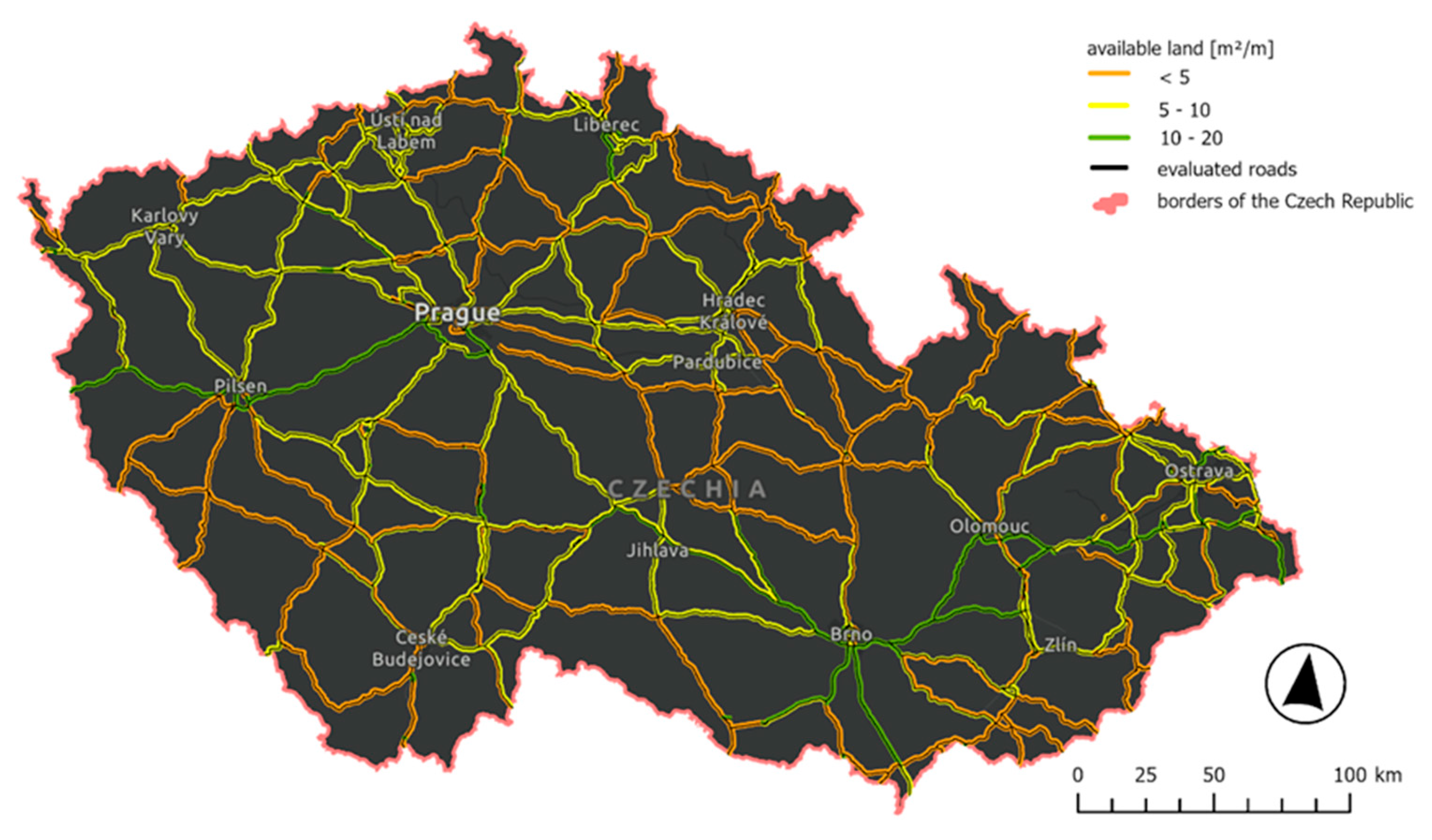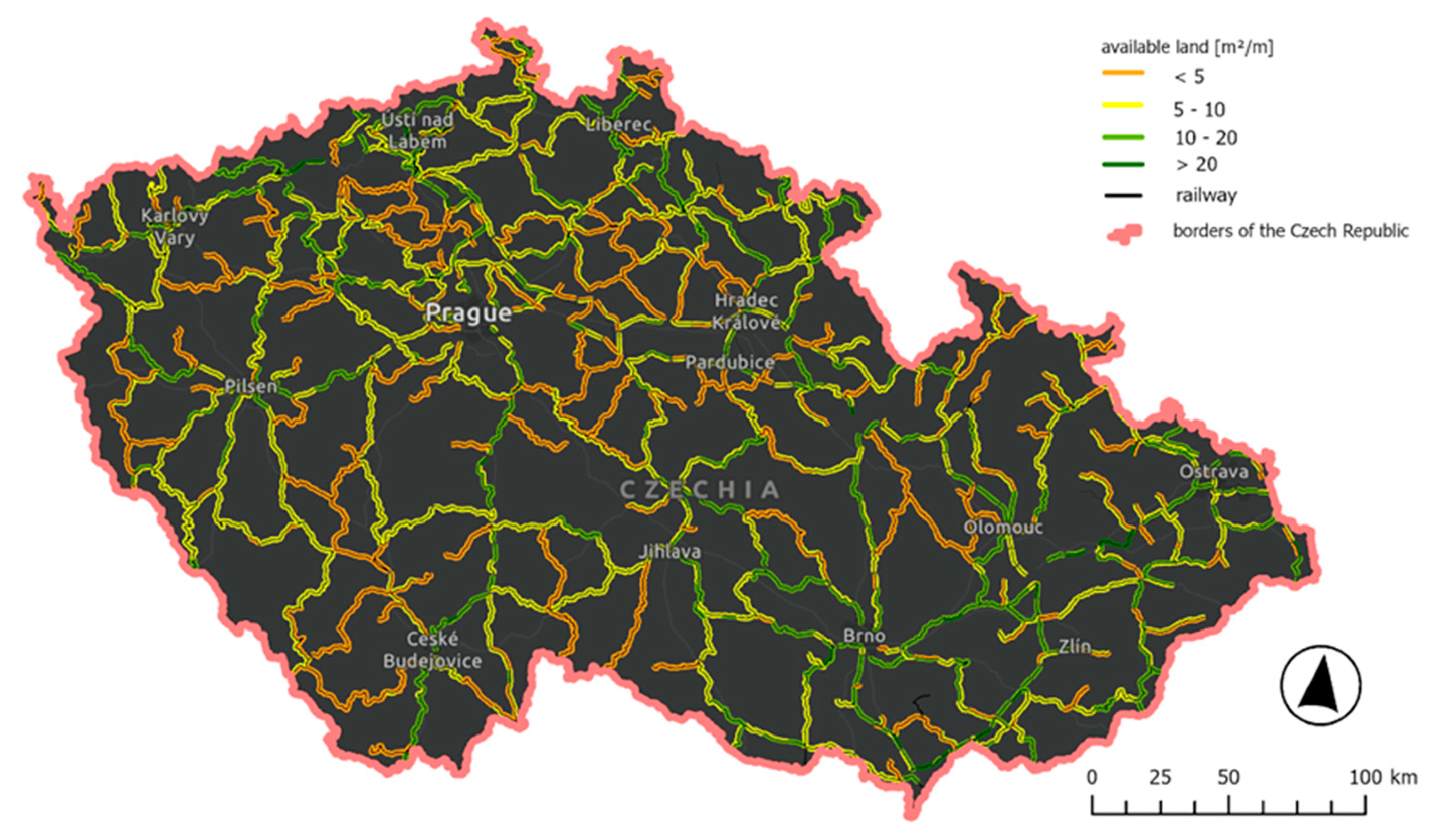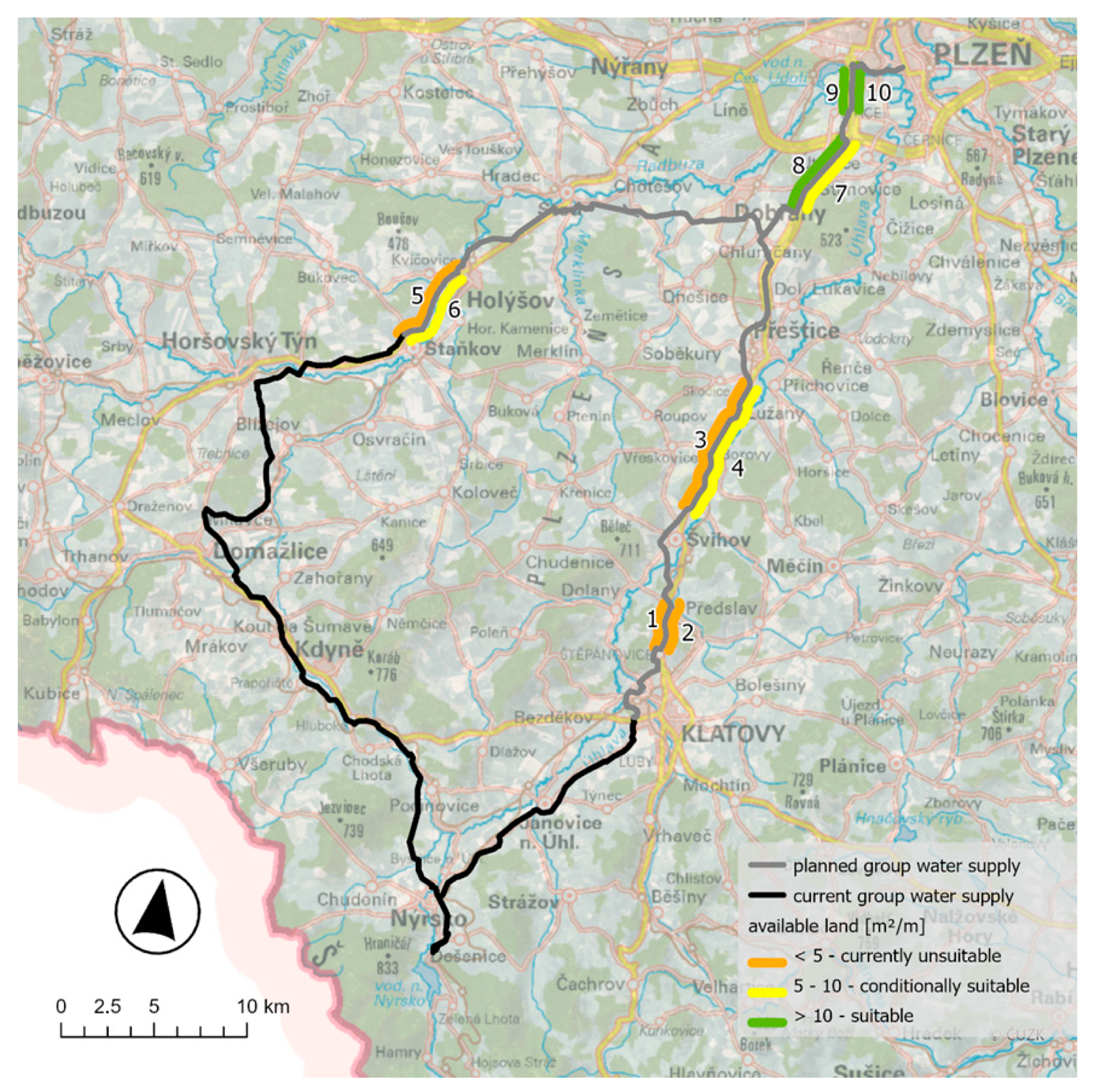Evaluating Transport Corridors for the Integration of Water-Transfer Infrastructures—A Case Study from the Czech Republic
Abstract
1. Introduction
2. Materials and Methods
2.1. Method for Evaluating the Suitability of Installing Water Infrastructure
2.2. Evaluation of Railway Transportation
2.3. Case Study—Connecting the Nýrsko Water Source with the City of Plzeň
3. Results
4. Discussion
5. Conclusions
Author Contributions
Funding
Institutional Review Board Statement
Informed Consent Statement
Data Availability Statement
Conflicts of Interest
References
- WHO/UN-Water, Water-Related Challenges, UN.org. 2023. Available online: https://www.un.org/en/global-issues/water (accessed on 9 July 2025).
- Söller, L.; Luetkemeier, R.; Müller Schmied, H.; Döll, P. Groundwater stress in Europe—Assessing uncertainties in future groundwater discharge alterations due to water abstractions and climate change. Front. Water 2024, 6, 1448625. [Google Scholar] [CrossRef]
- Wojkowski, J.; Wałęga, A.; Młyński, D.; Radecki-Pawlik, A.; Lepeška, T.; Piniewski, M.; Kundzewicz, Z.W. Are we losing water storage capacity mostly due to climate change? Analysis of the landscape hydric potential in selected catchments in East-Central Europe. Ecol. Indic. 2023, 154, 110913. [Google Scholar] [CrossRef]
- Debaere, P.; Kapral, A. The potential of the private sector in combating water scarcity: The economics. Water Secur. 2021, 13, 100090. [Google Scholar] [CrossRef]
- European Environment Agency. Europe’s State of Water 2024: The Need for Improved Water Resilience; EEA Report No 07/2024; Publications Office of the EU: Luxembourg, 2024. [Google Scholar] [CrossRef]
- Siddik, M.A.B.; Dickson, K.E.; Rising, J.; Emanuel, R.E.; Duvall, A.; Lin, Y.-P.; Ruddell, B.L. Interbasin water transfers in the United States and Canada. Sci. Data 2023, 10, 27. [Google Scholar] [CrossRef] [PubMed]
- Cirilo, J.A.; Ribeiro Neto, A.; Ramos, N.M.R.; Fortunato, C.F.; de Souza, J.D.S.; Bezerra, S.d.T.M. Management of water supply systems from interbasin transfers: Case study in the Brazilian semiarid region. Urban Water J. 2021, 18, 660–671. [Google Scholar] [CrossRef]
- Bernabé-Crespo, M.B.; Loáiciga, H. Managing potable water in southeastern Spain, Los Angeles, and Sydney: Transcontinental approaches to overcome water scarcity. Water Resour. Manag. 2024, 38, 1299–1313. [Google Scholar] [CrossRef]
- Dobbs, G.R.; Liu, N.; Caldwell, P.V.; Doyle, M.W.; Konar, M. Inter-basin surface water transfers database for public water supplies in conterminous United States, 1986–2015. Sci. Data 2023, 10, 255. [Google Scholar] [CrossRef]
- Laassilia, O.; Ouazar, D.; Bouziane, A.; Hasnaoui, M.D. Estimation of excess water in the Sebou basin for an interbasin water transfer. J. Appl. Water Eng. Res. 2021, 9, 69–87. [Google Scholar] [CrossRef]
- Murgatroyd, A.; Gavin, H.; Becher, O.; Coxon, G.; Hunt, D.; Fallon, E.; Wilson, J.; Cuceloglu, G.; Hall, J.W. Strategic analysis of the drought resilience of water supply systems. Philos. T. Roy. Soc. A 2022, 380, 20210292. [Google Scholar] [CrossRef]
- Liu, Y.; Xin, Z.; Sun, S.; Zhang, C.H.; Fu, G. Assessing environmental, economic, and social impacts of inter-basin water transfer in China. J. Hydrol. 2023, 625 Pt A, 130008. [Google Scholar] [CrossRef]
- Kuhn, D.; Luetkemeier, R.; Frick-Trzebitzky, F.; Söller, L.; Fehrs, K. Infrastructural lock-ins in the temporal and spatial development of a long-distance water transfer in Germany. J. Hydrol. 2024, 634, 131070. [Google Scholar] [CrossRef]
- Faúndez, M.; Echeverría, D.; Díaz, A.; Peña, H.; Vargas, X. Sustainability of water transfer projects: A systematic review. Sci. Total Environ. 2023, 860, 160500. [Google Scholar] [CrossRef]
- Wang, X.; Dong, Z.; Wang, W.; Tan, Y.; Zhang, T.; Han, Y. Regional water allocation for coordinated development among the social, economic and environmental systems. AQUA—Water Infrastruct. Ecosyst. Soc. 2021, 70, 550–569. [Google Scholar] [CrossRef]
- Purvis, L.; Dinar, A. Are intra- and inter-basin water transfers a sustainable policy intervention for addressing water scarcity? Water Secur. 2020, 9, 100058. [Google Scholar] [CrossRef]
- Khadem, M.; Watts, G.; Dadson, S.; Tanguy, M.; Hannaford, J. The feasibility of inter-basin water transfers to manage climate risk in England. Clim. Risk Manag. 2021, 33, 100322. [Google Scholar] [CrossRef]
- Rollason, E.; Sinha, P.; Bracken, L.J. Interbasin water transfer in a changing world: A new conceptual model. Prog. Phys. Geog. 2022, 46, 371–397. [Google Scholar] [CrossRef]
- Zhong, H.; Liao, T.; Fang, G.; Ren, K.; Zhang, S. Exploring optimal joint operating rules for large-scale inter-basin water transfer projects with multiple water sources, diversion routes, and water demand areas. J. Hydrol. Reg. Stud. 2023, 49, 101504. [Google Scholar] [CrossRef]
- Ministry of Agriculture of the Czech Republic. Report on the State of Water Management in the Czech Republic in 2023. 2023. Available online: https://mze.gov.cz/public/portal/mze/-a52982---T_okw9lF/zprava-o-stavu-vodniho-hospodarstvi-ceske-republiky-v-roce-2023?_linka=a597886 (accessed on 9 July 2025).
- Caithamlová, M.; Kročová, Š.; Mariňáková, J. Operation of water supply systems in the Czech Republic—Risk analysis. Appl. Sci. 2024, 14, 1572. [Google Scholar] [CrossRef]
- Hejduková, P.; Marval, Š.; Roub, R.; Zrostlík, Š.; Kopp, J.; Hejduk, T.; Sychová, P.; Kureková, L.; Pavlíčková, L.; Bureš, L.; et al. Dostupnost Pitné Vody pro Obyvatele Malých Obcí jako Indikátor Socio-Ekonomického Rozvoje Společnosti. Certifikovaná Metodika. 2021. Available online: https://agronavigator.cz/sites/default/files/users/user291/Metodiky/e_metodika_zapivo.pdf (accessed on 9 July 2025).
- Hejduková, P.; Zrostlík, Š.; Hejduk, T. Propojování Vodárenských Soustav jako Efektivní Řešení pro Zajištění Kvalitního Zdroje Vody. TZB-info. 2022. Available online: https://voda.tzb-info.cz/vlastnosti-a-zdroje-vody/23440-propojovani-vodarenskych-soustav-jako-efektivni-reseni-pro-zajisteni-kvalitniho-zdroje-vody (accessed on 9 July 2025).
- Meitner, J.; Štěpánek, P.; Skalák, P.; Dubrovský, M.; Lhotka, O.; Penčevová, R.; Zahradníček, P.; Farda, A.; Trnka, M. Validation and selection of a representative subset from the ensemble of EURO-CORDEX EUR11 regional climate model outputs for the Czech Republic. Atmosphere 2023, 14, 1442. [Google Scholar] [CrossRef]
- Kundzewicz, Z.W.; Mata, L.J.; Arnell, N.W.; Döll, P.; Kabat, P.; Jiménez, B.; Miller, K.A.; Oki, T.; Sen, Z.; Shiklomanov, I.A. The implications of projected climate change for freshwater resources and their management. Hydrol. Sci. J. 2008, 53, 3–10. [Google Scholar] [CrossRef]
- Vizina, A.; Vysoč, P.; Kožín, R.; Nováková, H. Potenciál chráněných území pro akumulaci povrchových vod pro zmírnění dopadů klimatické změny na zásobování pitnou vodou. Vodohospodářské Tech.-Ekon. Inf. 2023, 65, 32–41. [Google Scholar] [CrossRef]
- Raj, S.; Bansal, V.K. Use of GIS for selection of optimal route for water pipelines in hill areas. Innov. Infrastruct. Solut. 2024, 9, 13. [Google Scholar] [CrossRef]
- Minaei, A.; Abusamra, S.; Hajibabaei, M.; Savic, D.; Zecchin, A.C.; Creaco, E.; Sitzenfrei, R. Optimized phased planning for dynamic rehabilitation of integrated municipal infrastructure. AQUA—Water Infrastruct. Ecosyst. Soc. 2024, 73, 1389–1405. [Google Scholar] [CrossRef]
- Mosbach, J.; Krämer, M.; Fiedler, J.E.; Sonnenburg, A.; Urban, W. Combined districting and main line routing—A method to implement a basic drinking water supply infrastructure in informal settlements. Water 2022, 14, 2805. [Google Scholar] [CrossRef]
- Motiee, H.; Khalili, R.; Gholami, B.; Ghorbani, M.A.; Dastorani, M.T. A decision making approach for water transfer systems by Analytical Hierarchy Process (AHP) and GIS. Water Resour. Manag. 2023, 37, 4623–4637. [Google Scholar] [CrossRef]
- Czech Office for Surveying, Mapping and Cadastre (ČÚZK). INSPIRE Theme—Transport Networks—Road Transport; Data Specification and Accuracy of ZABAGED®; ČÚZK: Prague, Czech Republic, 2020; Available online: https://geoportal.cuzk.cz/(S(k5ihzevprysew0wfuwb0flko))/Default.aspx?lng=CZ&mode=TextMeta&side=zabaged&metadataID=CZ-CUZK-TN_ROAD-V&mapid=8&menu=248 (accessed on 2 September 2025).
- Czech Office for Surveying, Mapping and Cadastre (ČÚZK). INSPIRE Theme—Transport Networks—Rail Transport; Data Specification of ZABAGED; ČÚZK: Prague, Czech Republic, 2020; Available online: https://geoportal.cuzk.cz/(S(k5ihzevprysew0wfuwb0flko))/Default.aspx?lng=CZ&mode=TextMeta&side=zabaged&metadataID=CZ-CUZK-TN_RAIL-V&mapid=8&menu=247 (accessed on 2 September 2025).
- Czech Office for Surveying, Mapping and Cadastre (ČÚZK). Register of Territorial Identification, Addresses and Real Estate (RÚIAN); Data Documentation; ČÚZK: Prague, Czech Republic, 2024; Available online: https://vdp.cuzk.cz (accessed on 2 September 2025).
- European Parliament and Council of the European Union. Directive 2007/2/EC Establishing an Infrastructure for Spatial Information in the European Community (INSPIRE). Off. J. Eur. Union 2007, L 108, 1–14. [Google Scholar]
- Marval, Š.; Zrostlík, Š.; Hejduk, T.; Fučík, P.; Mašek, O.; Zajíček, A.; Poláková, L.; Slavík, P.; Kasal, R.; Anderlová, B. Využití Koridorů Dopravních Liniových Staveb k Dodávce Pitné a Závlahové vody do Deficitních Oblastí. In Specializovaná mapa s odborným obsahem; VUMOP: Prague, Czech Republic, 2024; p. 133. ISBN 978-80-88664-08-6. [Google Scholar]
- ČSN 73 6360-1; Czech Technical Standard ČSN 73 6360-1: Structural and Geometric Arrangement of Railway Tracks and Their Spatial Position—Part 1: Design. Czech Office for Standards, Metrology and Testing (ÚNMZ): Prague, Czech Republic, 2014.
- Zrostlík, Š.; Hyšplerová, M.; Mašek, O. Sjednocení Studií Proveditelnosti „Propojení Skupinových vodovodů Nýrsko-Klatovy, Švihov, Přeštice, Dobřany a Plzeňská aglomerace” a „Propojení vodovodu Nýrsko-Domažlice-Holýšov s Plzeňskou Aglomerací-SP”. 2022. Available online: https://www.plzensky-kraj.cz/sjednoceni-studii-proveditelnosti-propojeni-skupi (accessed on 9 July 2025).
- Mazumder, R.K.; Salman, A.M.; Li, Y.; Yu, X. Asset Management Decision Support Model for Water Distribution Systems: Impact of Water Pipe Failure on Road and Water Networks. J. Water Res. Plan. Man. 2021, 147, 04021022. [Google Scholar] [CrossRef]
- Act No. 13/1997 Coll., on Roads [Zákon č. 13/1997 Sb., o Pozemních Komunikacích]. Collection of Laws of the Czech Republic. Available online: https://www.zakonyprolidi.cz/cs/1997-13 (accessed on 2 September 2025).
- Act No. 266/1994 Coll., on Railways [Zákon č. 266/1994 Sb., o Drahách]. Collection of Laws of the Czech Republic. Available online: https://www.zakonyprolidi.cz/cs/1994-266 (accessed on 2 September 2025).
- Act No. 274/2001 Coll., on Water Supply and Sewerage Systems [Zákon č. 274/2001 Sb., o vodovodech a kanalizacích]. Collection of Laws of the Czech Republic. Available online: https://www.zakonyprolidi.cz/cs/2001-274 (accessed on 2 September 2025).
- ČSN 75 5409; ČSN 75 5409: Design of Water Mains [ČSN 75 5409: Navrhování vodovodních řadů]. Czech Office for Standards, Metrology and Testing: Prague, Czech Republic, 2012.
- Mašek, O.; Zrostlík, Š.; Hejduk, T.; Fučík, P.; Marval, Š.; Zajíček, A.; Poláková, L.; Kasal, R. Vyhodnocení Potřeby Vody pro Vodárenské Účely 2030+. In Specializovaná mapa s odborným obsahem; VUMOP: Prague, Czech Republic, 2024; 43p, ISBN 978-80-88664-02-4. [Google Scholar]







| Dataset name | Dataset Description | Parameters | Data Source |
|---|---|---|---|
| Road transport networks 1 (RTN1) | Spatial layout of road transportation—only single line for a road corridor (highways, expressways, and first-class roads); line.shp | Road transport networks geometry | The Transport Research Center |
| Road transport networks 2 (RTN2) | Spatial layout of traffic lanes includes road width data—a line for each traffic lane (highways, expressways, and first-class roads), line.shp | Road transport networks geometry, road number, width for road | INSPIRE—Theme—Transport Networks—Road Transport—Dataset for Defining the Road Body |
| Railway transport networks | Spatial layout of the railway transportation includes number of railway tracks, line.shp | Railway transport networks geometry, number of tracks | INSPIRE—Theme—Transport Networks—Rail Transport—Dataset for Defining the Railway Body |
| Cadastral data | Localization of lands owned by the Czech Republic—Management rights for the Road and Motorway Directorate and the Railway Administration (RMDRA), polygon.shp | Land parcel geometry | Czech Office for Surveying, Mapping and Cadastre—Register of Territorial Identification, Addresses, and Real Estate |
| Available Land (m2/m) | Suitability of Water-Transfer Infrastructure Installation |
|---|---|
| 0.00–40.00 | Very Suitable |
| 10.00–20.00 | Suitable |
| 5.00–10.00 | Conditionally Suitable |
| 0.01–5.00 | Currently Unsuitable |
| 0.00 | Not Assessed |
| Type of Transport | Categories | Number of 500 m Sections | Total Length [km] | % by Type of Transport |
|---|---|---|---|---|
| road | very suitable | 1411 | 728.66 | 5.3 |
| road | suitable | 4902 | 2575.04 | 18.3 |
| road | conditionally suitable | 4688 | 2484.78 | 17.5 |
| road | currently unsuitable | 14,092 | 7526.99 | 52.5 |
| road | not assessed | 1759 | 896.05 | 6.6 |
| railway | very suitable | 1534 | 766.45 | 4.9 |
| railway | suitable | 6501 | 3251.93 | 20.8 |
| railway | conditionally suitable | 9325 | 4675.45 | 29.8 |
| railway | currently unsuitable | 12,580 | 6289.09 | 40.3 |
| railway | not assessed | 1303 | 642.87 | 4.2 |
| Section ID | Type of Road | Suitability of Water-Transfer Infrastructure Installation | Length [km] | Available Land [m2] | Available Land [m2/m] |
|---|---|---|---|---|---|
| 10 | expressways | suitable | 2.28 | 32,355.5 | 14.2 |
| 8 | expressways | suitable | 4.45 | 48,425.7 | 10.9 |
| 9 | expressways | suitable | 2.27 | 24,287.4 | 10.7 |
| 4 | first-class roads | conditionally suitable | 7.71 | 72,626.3 | 9.4 |
| 7 | expressways | conditionally suitable | 4.44 | 40,846.9 | 9.2 |
| 6 | first-class roads | conditionally suitable | 4.90 | 25,463.8 | 5.2 |
| 5 | first-class roads | currently unsuitable | 4.85 | 24,164.2 | 5.0 |
| 3 | first-class roads | currently unsuitable | 7.71 | 30,181.3 | 3.9 |
| 2 | first-class roads | currently unsuitable | 2.48 | 8888.1 | 3.6 |
| 1 | first-class roads | currently unsuitable | 2.46 | 8195.2 | 3.3 |
Disclaimer/Publisher’s Note: The statements, opinions and data contained in all publications are solely those of the individual author(s) and contributor(s) and not of MDPI and/or the editor(s). MDPI and/or the editor(s) disclaim responsibility for any injury to people or property resulting from any ideas, methods, instructions or products referred to in the content. |
© 2025 by the authors. Licensee MDPI, Basel, Switzerland. This article is an open access article distributed under the terms and conditions of the Creative Commons Attribution (CC BY) license (https://creativecommons.org/licenses/by/4.0/).
Share and Cite
Marval, Š.; Fučík, P.; Hejduk, T.; Zrostlík, Š.; Mašek, O.; Kaplická, M. Evaluating Transport Corridors for the Integration of Water-Transfer Infrastructures—A Case Study from the Czech Republic. Appl. Sci. 2025, 15, 9990. https://doi.org/10.3390/app15189990
Marval Š, Fučík P, Hejduk T, Zrostlík Š, Mašek O, Kaplická M. Evaluating Transport Corridors for the Integration of Water-Transfer Infrastructures—A Case Study from the Czech Republic. Applied Sciences. 2025; 15(18):9990. https://doi.org/10.3390/app15189990
Chicago/Turabian StyleMarval, Štěpán, Petr Fučík, Tomáš Hejduk, Štěpán Zrostlík, Ondřej Mašek, and Markéta Kaplická. 2025. "Evaluating Transport Corridors for the Integration of Water-Transfer Infrastructures—A Case Study from the Czech Republic" Applied Sciences 15, no. 18: 9990. https://doi.org/10.3390/app15189990
APA StyleMarval, Š., Fučík, P., Hejduk, T., Zrostlík, Š., Mašek, O., & Kaplická, M. (2025). Evaluating Transport Corridors for the Integration of Water-Transfer Infrastructures—A Case Study from the Czech Republic. Applied Sciences, 15(18), 9990. https://doi.org/10.3390/app15189990






